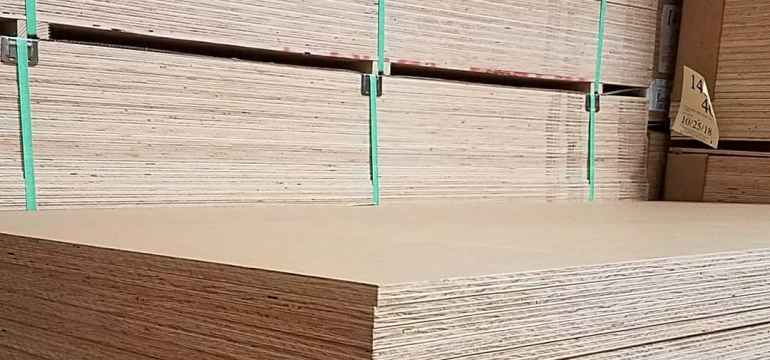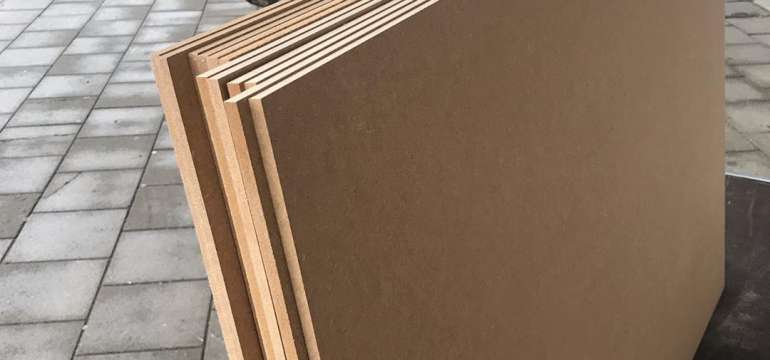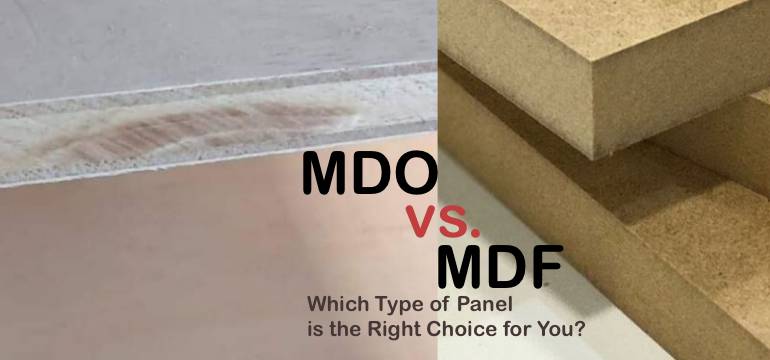It is easy to become overwhelmed by all of the different types of wood products available at your local lumberyard. From OSB to MDF to MDO and more, you are bombarded with options that look similar to one another but come with drastically different price tags.
How can you easily decide which type of panel is right for your project when everything looks so similar at a quick glance? Before you start your next project, you should know all of the benefits of MDO vs. MDF included in this short guide.
What is MDO Plywood?

Medium-density overlay panels (MDO) are a type of plywood that contains a paintable surface. It combines a weather-resistant resin overlay with a wooden core to help this particular type of panel to hold up well when facing the elements.
The overlay has a minimum of 27 percent resin to help it better withstand water, weather, and other forms of wear and tear. You may be able to paint one or both sides.
One of the main attributes that set MDO plywood apart is its actual veneers. It is constructed of thin wooden layers held together by a waterproof adhesive.
This type of panel is ideal for sign painting, and anywhere a paint finish is the end goal. According to some experts, the paint is three times more durable on MDO panels when compared to a sheet of traditional standard plywood. This is great news for those who are looking for a relatively inexpensive way to advertise their business or paint a sign for a coming attraction.
Many people like to use MDO in the exterior construction of their home for siding, fascia, or soffits. It can easily be embossed with wood grain patterns to make it appear more natural for your siding.
Keep in mind that MDO is also extremely durable. While it can definitely be painted and used in a well-finished project, it is also a very rugged type of plywood. Some people even use this as the interior for railroad boxcars or for floor panels on the interior of a trailer. It can definitely withstand a great deal of traffic and pressure despite its appearance.
What is MDF?

Medium-density fiberboard (MDF) sounds a lot like medium-density overlay, but the two could not be further apart. Understanding the construction of MDF will help you to better spot the primary differences between the two.
First, it is important to understand exactly what the core of these boards is made of. It is relatively sustainable and environmentally friendly. It uses all of the byproducts that are associated with industrial milling: sawdust and wood shavings, primarily. Those small wood byproducts are dehydrated and combined with resin and wax to form panels.
The panels are then subjected to high heat and extreme pressure to force them to become the rigid end product that you are familiar with. They have a hard outer shell that is then sanded down to create a smooth surface.
Because these panels are not made of real wood veneers, many people prefer working with MDF. It has no knots, no grain patterns, and none of the warping that can occur with traditional plywood.
In addition to the perks of working with MDF, many people love the budget that accompanies an MDF project. It tends to be less expensive than traditional plywood with sheets usually costing less than fifty dollars each.
One thing that you do need to keep in mind with MDF is that the boards are very heavy and can be difficult to handle. You may want to consider taking someone else with you to the lumberyard if you plan to purchase MDF. Move cautiously with each sheet because the edges and corners are very easy to break or damage, and the surface can become scratched relatively easily.
MDO vs. MDF
 Now that you know just how each one is made and what it can be used for, it is time to take a much closer look at the differences between the two. When you directly compare MDO vs. MDF, which one should you use for your next project? Here are just a few of the things that you should be aware of.
Now that you know just how each one is made and what it can be used for, it is time to take a much closer look at the differences between the two. When you directly compare MDO vs. MDF, which one should you use for your next project? Here are just a few of the things that you should be aware of.
Density
Density is an important attribute to consider when working with wood to design your next project. This measurement denotes just how durable your wood is going to be when it comes to withstanding dents and dings. Unfortunately, many people are misled to believe that both MDO and MDF have the same degree of density since they are both considered to be “medium.”
In reality, MDO is denser than MDF. It was originally designed to help in situations where MDF fell short due to its weaker construction. As a result, the engineering process behind MDO and MDF is significantly different and produces much different density results.
Strength
Which type of panel is going to be the right fit for you based on strength? While both are relatively durable, MDO does win in this category as well. It can support heavier weights and upholds its structural integrity over time.
Tensile strength is the measurement used to denote the force required to pull something to the point where it will actually break in two. To give you an idea of how weak MDF can be, it has a tensile strength of just 90 pounds for a standard 4×8 sheet.
Workability
The truth is that both products are fairly easy to work with. They are much softer on tools than the standard plywood, or solid hardwood would be. For the most part, they are pretty pliable. They both even have sanded and smooth surfaces that are almost ready to accept a final coat of paint. Keep in mind that they are better off painted than stained or finished in any other manner.
However, there are still some minor differences between MDO and MDF that you might want to be aware of if you are building something. Primarily, MDO will accept screws much better than MDF. This can be an important factor if you need to fasten something together for your latest project.
If you are working in an enclosed area and are worried about the mess, you might also want to opt for the MDO. Cutting and working with this type of panel is less messy than working with the sandy mess that MDF can create.
MDF tends to produce a lot of powdery sawdust that easily coats everything in your workspace and can even make it difficult to breathe. You will need to plan to thoroughly vacuum and clean your area after you are finished working with MDF.
Application
MDO and MDF are really very similar and can often be used interchangeably. There are a few times when the application will really make the decision for you, though. One of these situations is if you happen to be making something for exterior use. MDO is designed to be weather-resistant and is constructed with waterproof adhesives. MDF is often untreated and cannot stand up to the rain, snow, and sleet.
You should also consider the humidity levels that will be found in the area where you keep your finished project. MDF does not hold up well to extended periods of high humidity or in areas where it will be exposed to a lot of UV rays. Over time, these two items can jeopardize the bond of the resin and cause the panel to come apart.
Health Risk
While MDF is sustainable because it uses the byproducts associated with milling, it does pose some potential health concerns. The adhesive used to bind it all together often contains urea-formaldehyde, a suspected cancer-causing agent. While it is in its untreated state, the MDF will continue to off-gas.
Make sure that you keep it in a well-ventilated area, work with it outdoors, or wear a respirator to protect yourself from long-term harm. This risk decreases when you seal the MDF.
Price
For many woodworkers, their final decision rests on the bottom line. Which product is going to be more affordable? They both finish well and are designed to be painted over, so the end look will be similar whether you choose to use MDO or MDF. The cost is the real deciding factor in many scenarios.
Because MDF is manufactured using scraps and requires a less intensive manufacturing process, it is the less expensive material. Both will come in well below the price of a solid hardwood, but MDF is the less expensive out of the two.
Is MDF or MDO Right for You?
Choosing between MDF and MDO panels can seem like a small decision, but it can make a major difference in how your projects turn out. In many situations, MDO is the clear winner. It is more durable, stronger, more resistant to weather, and less messy to work with than MDF. However, MDF will be the less expensive option.
While you will have very similar looks with both finished products, it is important to make sure you understand the subtle differences between them. This will help you to make an educated decision about what is right for your next project.
- How to Cut Lexan - September 25, 2020
- Mineral Spirits vs. Mineral Oil - September 25, 2020
- Shellac vs. Polyurethane - September 24, 2020
